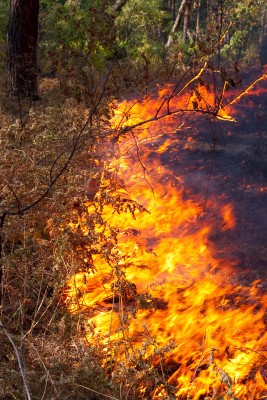Burning Questions Remain For Big Pine Key Refuge
 On the morning of September 15, 2011, a short time after 10:00 a.m., a crew from the National Key Deer Refuge lit a fire a mile north of Blue Hole on Big Pine Key. The intended burn was 21 acres in size, despite the fact that it included a two and a half acre hammock containing rare Liguus tree snails.
On the morning of September 15, 2011, a short time after 10:00 a.m., a crew from the National Key Deer Refuge lit a fire a mile north of Blue Hole on Big Pine Key. The intended burn was 21 acres in size, despite the fact that it included a two and a half acre hammock containing rare Liguus tree snails.
By 11:00 a.m., the fire was already out of control, jumping the fire lines, and rushing south at a high rate of speed toward the Pine Heights subdivision of 43 homes. A forestry official from the Florida Dept. of Forestry was being transported to the hospital for heat exhaustion and the local fire departments were being contacted.
The fire had been started, despite the fact that the small test fire that is done before a prescribed burn, was over seven feet high. Normally test fires are one to two feet in height. By 4:00 p.m. that afternoon, the fire was still out of control, and the hundred or so residents of Pine Heights were told to leave their homes, or not allowed in upon returning from work.
The pine rockland habitat was bone dry and high winds coming from the northeast had pushed the wall of fire south all day. The inexperienced crew had expected the winds to be from the southeast. Most residents were surprised that any fire was taking place at all and almost no one outside of Port Pine Heights had been notified.
Facts
Shortly after the September 15 wildfire, in late September, the NKDWR held a public meeting to explain what went wrong to BPK residents. In the November 25, 2011 News Barometer, the headline was, “Refuge To Adopt New Burn Guidelines”:
“After a planned 21-acre burn flamed out of control and burned an additional 100 acres… local residents particularly those in Pine Heights, were quite upset with the Refuge. Most who spoke out against the burns simply asked the refuge to stop the practice because of the proximity of the burn units to residential neighborhoods.”
Anne Morkill [the Refuge manager at the time] announced that fire would continue to be part of the refuge habitat management plan in the future. The Refuge’s fire management plan calls for a burn cycle of eight to twelve years for pine rockland habitat. But on July 20, 2012, Morkill signed off on a plan that would conduct a burn on a strip along Key Deer Blvd. after only three years. That burn did not take place that year, but that unit and another along Big Pine Street are planned for the near future in 2013, after less than four years.
This year the refuge intends to burn 3 parcels. Although they are thankfully small, they all have been burned recently, well under the 8-12 year burn cycle publicly affirmed in November 2011. The most important one is east of Key Deer Blvd., south of Blue Hole. It is part of a Pleistocene ridge; the longest and highest ridge of its kind in the Lower Keys. The sinkholes along this ridge contain unique plant communities found nowhere else in the Keys. The last Bay trees, Persea borbonea are found here, along with some of the very last wild Satinleaf trees on Big Pine Key. The several hundred Satinleaf trees previously occurring on Big Pine were destroyed by fires, construction of fire roads, and the storm surge of Hurricane Wilma in 2005.
Part of the reasoning for this fire is that there is a small population of native Croton on the tract, and that a fire will cause the Croton to increase in abundance. The Croton is the only host plant for the Bartram’s Scrub Hairstreak butterfly. This butterfly is on the verge of extinction and is being considered for listing as an endangered species under federal laws.
But according to biological consultant Bob Ehrig, a member of the Pine Rocklands Citizens Task Force who has lived on Big Pine Key for 35 years and has long monitored controled burns in the Refuge,
“A fire could have exactly the opposite effect because the Key Deer will likely over-browse the re-sprouts of the Croton which could instead result in a reduction of the small population. It was only a decade ago when we had abundant Croton linearis in this area. Plants were two and three feet tall and the butterfly was seen daily. In the last five years, we noticed that the Key Deer were eating the Croton. They often kill the plants and reduce them to small size. An accurate count of the Key Deer population is needed to assess herd size and the impact on plant species in the Refuge.”
Additionally, there continue to be issues about thorough notification of residents on Big Pine. Notices of the recent open house meetings, while noticed in the papers and on the radio, were not posted publicly in high traffic areas such as Winn Dixie, CVS, and Walgreens. Despite promises made after the out of control burn, evacuation plans for disabled residents and those with health issues have not been put in place and communicated to residents.
Residents need to feel that they can depend on the Refuge to follow through on promises made after the out of control burn. The Pine Rocklands Citizens Task Force will continue to watch the plans for prescribed burns.
Deb Curlee,
Member, Pine Rocklands Citizens Task Force